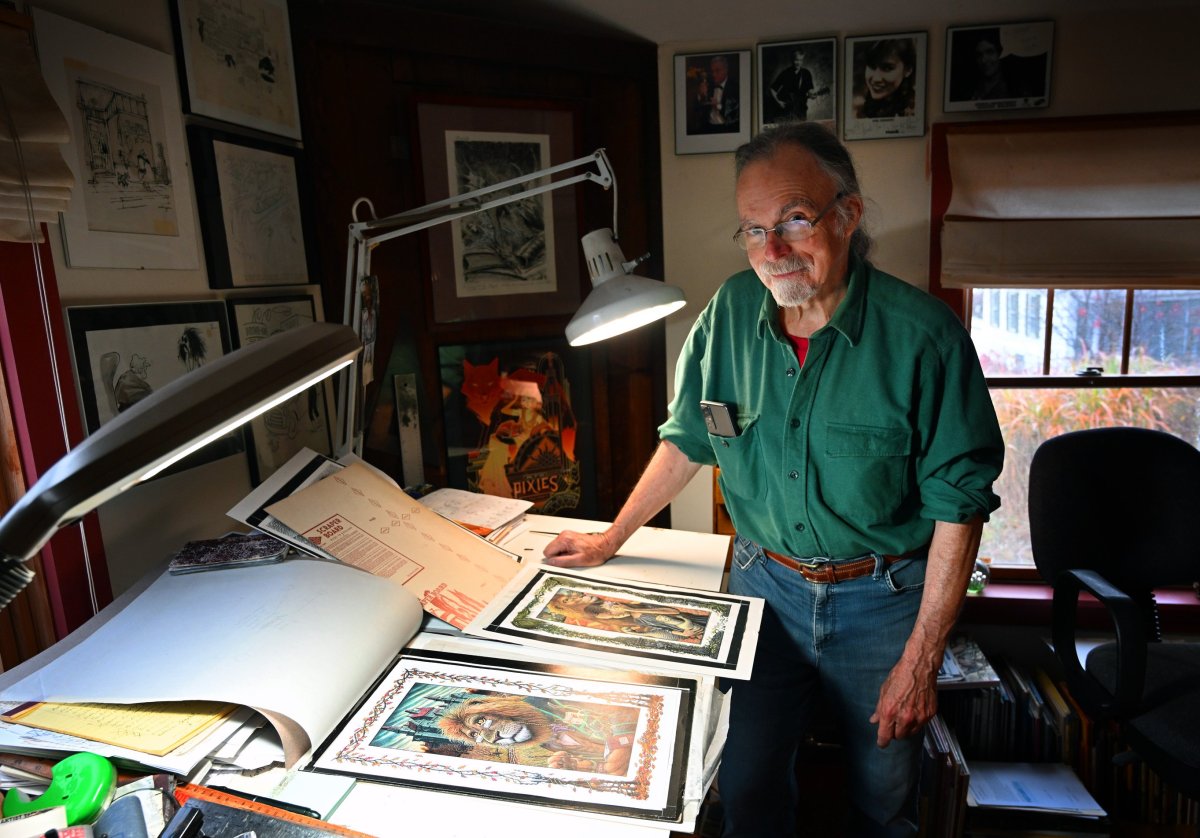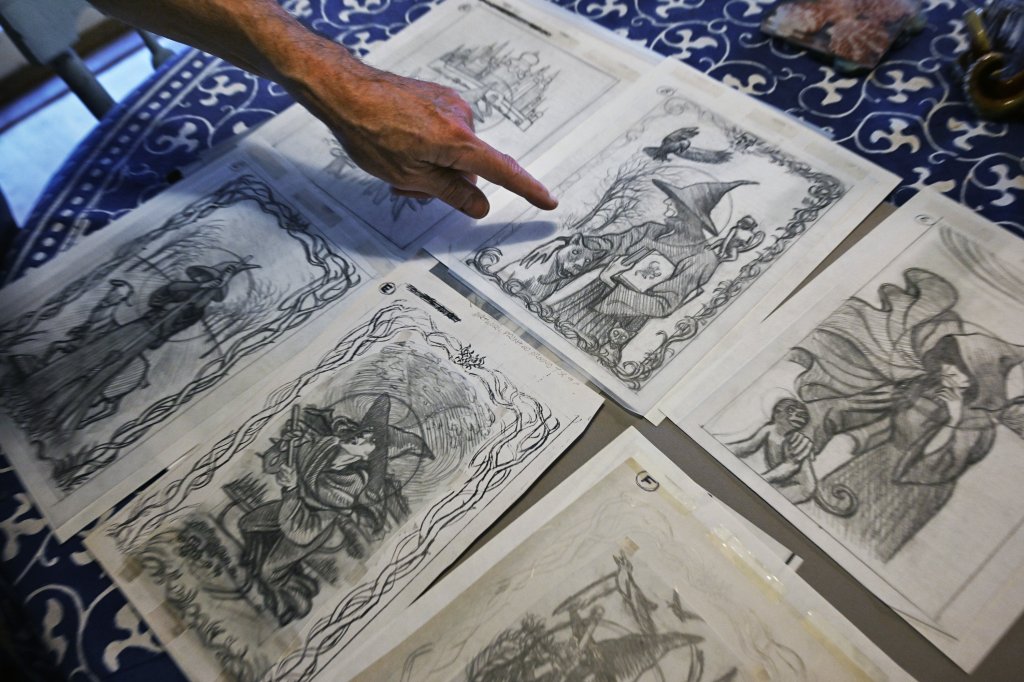
PEAKS ISLAND — Douglas Smith has never seen the long-running Broadway musical “Wicked” nor the blockbuster film of the same name, which came out last year.
Yet his own vision of the “Wicked” story was the first many people ever saw.
Smith illustrated the 1995 novel “Wicked” by Gregory Maguire, the inspiration for the 2003 musical and the movies. “Wicked: For Good,” part two of last year’s hit film, arrives in theaters nationwide on Nov. 21, with some scheduling early showings. Smith also illustrated Maguire’s three other books in the “Wicked” series, and recently finished a new cover image for a $420 “deluxe” edition of the original book, which will be available in December.
Smith wanted his art to be true to Maguire’s stories, which are darker and more nuanced than the musical or the movies. From what Smith has seen of ads for the movies, the films seem to focus on the “cutesy stuff” in the relationship between Elphaba, the wicked witch, and Glinda, the good witch. And they seem to be aimed at teen girls.
“That cutesy stuff has nothing to do with Elphaba in the book, she’s a hard nut. You are sympathetic to her, but she’s tough,” said Smith, 73, sitting in the living room of his Peaks Island home, a former summer cottage. “And she’s way prettier in the movie. She’s just a beautiful girl who happens to be green. But Gregory described her as having a chin that could cut paper and a nose that could slice you.”
Partly because he did new art for the new edition of “Wicked,” including adding color to the five original black-and-white illustrations, he’s curious about the new film. He says he’d like to see it “when time allows,” but would probably would want to rent or stream the first movie beforehand.

The “Wicked” books were inspired by L. Frank Baum’s 1900 novel “The Wonderful Wizard of Oz.” That book inspired the classic 1939 film “The Wizard of Oz.” Though Smith created the original illustrations for “Wicked,” another Mainer helped create perhaps the most enduring image of the Wicked Witch of the West, who was portrayed in the 1939 movie by Margaret Hamilton. Hamilton had an island home off Southport, near Boothbay Harbor, and spent summers there for the last 25 years or so of her life.
PAINSTAKING ART, FROM SCRATCH
Smith’s book illustration of Elphaba for “Wicked” shows the sharp chin and nose mentioned in the story, but the eyes are hidden under the wide brim of her hat. The viewer’s eyes are drawn to the lines of her dress and billowing of her cape, as well as the animals snuggling against her.
Some of Smith’s “Wicked” works have been displayed in exhibits around Maine. One of his illustrations for another book in the “Wicked” series, “A Lion Among Men,” is on view now through Jan. 31 at the Falmouth Memorial Library, as part of an exhibition called “The Great State of Illustration in Maine.” It shows a dignified and serious lion, wearing glasses, a suit and bowtie, with an ominous castle behind him.

The exhibit was organized by the Portland-based Illustration Institute. That group is also working to create an archive in Portland that would preserve the work of Maine illustrators, and one of the first artists they’ve talked about including is Smith.
“Our goal is to make illustrators more visible. They often take a back seat to the author,” said Scott Nash, an illustrator himself who is executive director of the institute. “Doug would be one we’d like to start with. His work is well-known and his method is fascinating.”
Smith’s art is created using a scratchboard method, which is very labor-intensive and yields images that are incredibly detailed. It’s a somewhat “arcane” art form that Smith and a very few other artists are helping to keep alive, Nash said.
Smith starts by drawing the image. Using carbon paper, he traces every line of that image on top of the specially made scratch board paper, which includes a layer of black color on top of a white layer. Once the image is transferred to the scratchboard, he uses a scraping tool to scrape away parts of the black and reveal parts of the white, to create the image. He adds color to the illustration with watercolor paint.
Smith said he started doing scratchboard art in the 1970s, after working mostly in pencil, on a “lark.” But his work proved to be popular with clients and he found he soon had more work than he could handle.
“It’s a very slow process. When calls started coming in from all over the country, I had to turn orders down,” said Smith.

ART IN THE FAMILY
Smith grew up in Larchmont, a New York City suburb. His father was Dick Smith, an acclaimed movie makeup artist who worked on such major films as “The Godfather” (1972), The Exorcist” (1973) and “Taxi Driver” (1976). He won an Oscar for best makeup for “Amadeus” (1984) and won an Academy Honorary Award for his career’s work.
Douglas Smith was interested in his father’s art, but the two also shared a love for classic horror films of the 1930s and ’40s, like “Frankenstein,” “Dracula” and “The Wolf Man.” When he began drawing as a youngster, Smith mostly drew the kinds of things he saw in comic books and the newspaper’s funny pages. He studied illustration at the Rhode Island School of Design in Providence, with an eye toward being a comic book artist or cartoonist.
“The main thing that always interested me, and still interests me, about illustration and comic art is that they’re both done in the service of storytelling,” said Smith. “That maybe has something to do with my love of film, too. With a single illustration you’re telling only a snapshot of the story, like one frame of a movie.”
After earning his BFA in illustration in 1974, he moved to the Boston area. As a freelance artist, he worked for the Boston Globe, Boston Magazine and New England Monthly magazine, among others, while also working on advertisements and book illustrations. He’s done illustrations for seven of Maguire’s novels, including the four in the “Wicked Years” series. He also did 11 covers for editions of C.S. Forester’s “Hornblower” series.

Smith doesn’t get royalties from “Wicked” book sales. He says because Maguire was then a little-known author, his representative at the time advised him that a one-time payment would probably be worth more money.
“Nobody knew he was going to be famous,” Smith said of Maguire.
While living in the Boston area, Smith had come to Peaks Island many times to visit friends. Around 2004 he decided to move to the island full time. The walls of his home are filled with art of all kinds, by other artists.
His living room is filled with a hundred or more cat figurines, sculptures and images of cats. He was brought up with cats and has always loved them. One of the things he points out about the original “Wicked” story is that Elphaba is an animal activist, in his opinion, because she sticks up for the animals, who are being persecuted and having their rights stripped away.
Smith has worked over the years to help trap, neuter and release feral cats found on Peaks Island. During an interview for this story, a cat named Benny — who does not officially belong to Smith — sat on his lap.
“He just lives somewhere in the neighborhood but likes to come here,” Smith said. “He’s a wanderer, but I love him.”


We invite you to add your comments. We encourage a thoughtful exchange of ideas and information on this website. By joining the conversation, you are agreeing to our commenting policy and terms of use. More information is found on our FAQs. You can modify your screen name here.
Comments are managed by our staff during regular business hours Monday through Friday as well as limited hours on Saturday and Sunday. Comments held for moderation outside of those hours may take longer to approve.
Join the Conversation
Please sign into your CentralMaine.com account to participate in conversations below. If you do not have an account, you can register or subscribe. Questions? Please see our FAQs.